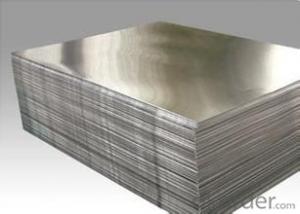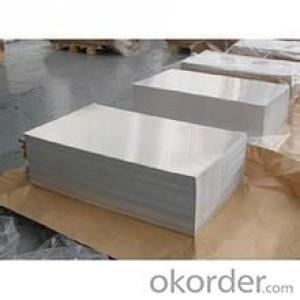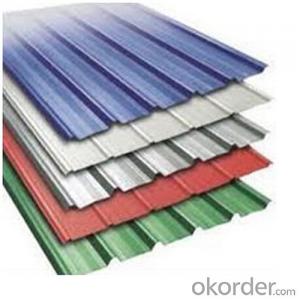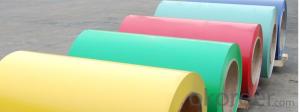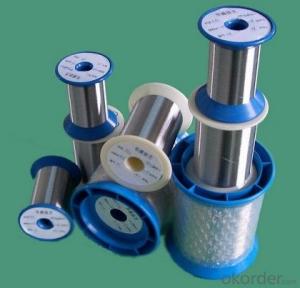Aluminum sheet and Corrugated Aluminum Sheet for some aplication
- Loading Port:
- China main port
- Payment Terms:
- TT or LC
- Min Order Qty:
- 100 m.t.
- Supply Capability:
- 100 m.t./month
OKorder Service Pledge
OKorder Financial Service
You Might Also Like
Aluminium foil acts as a total barrier to light and oxygen (which cause fats to oxidise or become rancid), odours and flavours, moistness, and germs, it is used broadly in food and pharmaceutical packaging. The purpose of aluminium is to make long-life packs (aseptic processing|aseptic packaging) for drinks and dairy goods, which allows storing without refrigeration. Aluminium foil containers and trays are used to bake pies and to pack takeaway meals, ready snacks and long life pet foods.
Aluminium foil is widely sold into the consumer market, often in rolls of 500 mm (20 in) width and several metres in length.It is used for wrapping food in order to preserve it, for example, when storing leftover food in a refrigerator (where it serves the additional purpose of preventing odour exchange), when taking sandwiches on a journey, or when selling some kinds of take-away or fast food. Tex-Mex restaurants in the United States, for example, typically provide take-away burritos wrapped in aluminium foil.
Aluminium foils thicker than 25 μm (1 mil) are impermeable to oxygen and water. Foils thinner than this become slightly permeable due to minute pinholes caused by the production process.
Aluminium foil has a shiny side and a matte side. The shiny side is produced when the aluminium is rolled during the final pass. It is difficult to produce rollers with a gap fine enough to cope with the foil gauge, therefore, for the final pass, two sheets are rolled at the same time, doubling the thickness of the gauge at entry to the rollers. When the sheets are later separated, the inside surface is dull, and the outside surface is shiny. This difference in the finish has led to the perception that favouring a side has an effect when cooking. While many believe that the different properties keep heat out when wrapped with the shiny finish facing out, and keep heat in with the shiny finish facing inwards, the actual difference is imperceptible without instrumentation.The reflectivity of bright aluminium foil is 88% while dull embossed foil is about 80%.
We provide a full range of precision aluminum strip for almost any application. We produce aluminum strip in a wide variety of alloys, including clad composites. Our aluminum strip can be produced in standard dimensions or custom made to your special requirements. We produce both imperial and metric units. We manufacture in compliance with the main international specifications, and tighter tolerances or custom tempers are available upon request. We offer various surface conditions, custom finishes (painting, anodizing, embossing), special processing, and multiple packaging options to meet our customer's unique requirements. The following is a summary of our capabilities.
Manufactured in compliance with the main international specifications and standards, including: Aluminum Association, ASTM, EN, and DIN.
We can also manufacture in compliance with other international standards including:ASME, SAE, AMS, AWS, FED, MIL, QQ, ISO, BS, AFNOR, JIS and GOST.
Manufactured in compliance with the main international specifications and standards.
Tighter tolerances are available upon request.
Aluminium (or aluminum; see spelling differences) is a chemical element in the boron group with symbol Al and atomic number 13. It is a silvery white, soft, ductile metal. Aluminium is the third most abundant element (after oxygen and silicon), and the most abundant metal in the Earth's crust. It makes up about 8% by weight of the Earth's solid surface. Aluminium metal is so chemically reactive that native specimens are rare and limited to extreme reducing environments. Instead, it is found combined in over 270 different minerals.The chief ore of aluminium is bauxite.
Aluminium is remarkable for the metal's low density and for its ability to resist corrosion due to the phenomenon of passivation. Structural components made from aluminium and its alloys are vital to the aerospace industry and are important in other areas of transportation and structural materials. The most useful compounds of aluminium, at least on a weight basis, are the oxides and sulfates.
Despite its prevalence in the environment, no known form of life uses aluminium salts metabolically. In keeping with its pervasiveness, aluminium is well tolerated by plants and animals. Owing to their prevalence, potential beneficial (or otherwise) biological roles of aluminium compounds are of continuing interest.
The earliest citation given in the Oxford English Dictionary for any word used as a name for this element is alumium, which British chemist and inventor Humphry Davy employed in 1808 for the metal he was trying to isolate electrolytically from the mineral alumina. The citation is from the journal Philosophical Transactions of the Royal Society of London: "Had I been so fortunate as to have obtained more certain evidences on this subject, and to have procured the metallic substances I was in search of, I should have proposed for them the names of silicium, alumium, zirconium, and glucium."
Davy settled on aluminum by the time he published his 1812 book Chemical Philosophy: "This substance appears to contain a peculiar metal, but as yet Aluminum has not been obtained in a perfectly free state, though alloys of it with other metalline substances have been procured sufficiently distinct to indicate the probable nature of alumina."[69] But the same year, an anonymous contributor to the Quarterly Review, a British political-literary journal, in a review of Davy's book, objected to aluminum and proposed the name aluminium, "for so we shall take the liberty of writing the word, in preference to aluminum, which has a less classical sound."
The -ium suffix conformed to the precedent set in other newly discovered elements of the time: potassium, sodium, magnesium, calcium, and strontium (all of which Davy isolated himself). Nevertheless, -um spellings for elements were not unknown at the time, as for example platinum, known to Europeans since the 16th century, molybdenum, discovered in 1778, and tantalum, discovered in 1802. The -um suffix is consistent with the universal spelling alumina for the oxide (as opposed to aluminia), as lanthana is the oxide of lanthanum, and magnesia, ceria, and thoria are the oxides of magnesium, cerium, and thorium respectively.
The aluminum spelling is used in the Webster's Dictionary of 1828. In his advertising handbill for his new electrolytic method of producing the metal in 1892, Charles Martin Hall used the -um spelling, despite his constant use of the -ium spelling in all the patents[58] he filed between 1886 and 1903. It has consequently been suggested[by whom?] that the spelling reflects an easier-to-pronounce word with one fewer syllable, or that the spelling on the flyer was a mistake.[citation needed] Hall's domination of production of the metal ensured that aluminum became the standard English spelling in North America.
The features of corrugated aluminum sheet is light weight (only steel 3/10), silver white and other colors, both decorative effect, but also a strong ability to reflect sunlight. It can fire, moisture, corrosion resistance, can be used in the atmosphere for more than 20 years. Relocation dismantled corrugated board can still be reused. Aluminum corrugated sheet is widely used in building decoration. It is suitable for hotels, restaurants, shopping malls and other buildings walls and roof decorations.
Corrugated aluminum sheet is made of aluminum alloy rolled sheet, its wavy cross section, is currently building a new type of building material widely used.
Only one-third of the proportion of aluminum steel, and has good ductility, very suitable for rolling process, in addition to aluminum also has a strong corrosion resistance, and therefore have important applications in the construction industry.
Aluminum and oxygen in the air after the chemical reaction, the surface will generate layer strong and dense oxide film. This layer of aluminum oxide film preservation became "coat", the internal aluminum is difficult for them to oxygen in the air to oxidation, so aluminum is placed in the atmosphere a year, which is less than the depth of corrosion of thousands of hours one millimeter. If the same time into the aluminum and steel containing 3% of sodium chloride and 1% of the hydrogen chloride in the container, the corrosion test of 70 hours, the average weight loss of steel per square centimeter 11.07 mg in weight loss of aluminum average of 0.675 milligrams per square centimeter, which proves the corrosion resistance of aluminum is generally much higher than the steel. However, the natural oxide film of aluminum, there are still shortcomings thin and soft, corrosion is not very strong, so that the service life of corrugated sheet aluminum untreated generally only about 20 years. If aluminum by chemical oxidation (i.e., at a certain temperature of the aluminum oxide surface cleaning and liquid oxygen in a chemical reaction) or electrochemical oxidation (i.e. the aluminum into the electrolyte, in the role of the applied current and oxygen ions the method of a direct reaction of water with aluminum surface cleaning) are processed, on the surface of the aluminum layer will generate 0.025 to about 0.05 millimeters thick and hard and even more some of the oxide film, so as to further improve the corrosion resistance of aluminum performance. After aluminum corrugated sheets thus treated, the service life of up to 60 years. Aluminum corrugated sheets can also be a variety of bright colors, it is possible to make the building more beautiful.
Lightweight aluminum corrugated board, use it to do the roof, asbestos-cement tiles per square meter than about 20 kg lighter. Aluminum is easy to implement plastic molding, rolling aluminum corrugated sheet length is unlimited, so use can reduce the number of joints, thereby increasing coverage. In addition, the high strength aluminum alloy corrugated board, use it to make building materials, particularly useful in earthquake-prone areas.
In short, aluminum corrugated board is a light weight, high strength, fire, beautiful, shock, easy transportation and construction many advantages such as excellent building materials.
- Q:I don't like purchasing deoderants that contain aluminum sulfate due to the fact that a build-up of aluminum may cause Alzheimer's (my grandfather has it). So, I purchased an all natural deoderant only to later look more closely at the labely and see POTASSIUM ALUM....hmmm, alum versus aluminum? Supposedly alum cannot be absorbed by the skin so it's safe....any proof?
- Is Alum Aluminum
- Q:Are the aluminum sheets suitable for manufacturing architectural roof systems?
- Yes, aluminum sheets are suitable for manufacturing architectural roof systems. Aluminum is lightweight, durable, corrosion-resistant, and easy to work with, making it an ideal material for constructing roof systems in architectural projects.
- Q:why is copper sheet but not aluminum sheet that becomes the negative pole after putting copper sheet and aluminum sheet connected with wire into concentrated nitric acid?
- According to metal reactivity series order table, aluminum has a better metallicity, but it will be passivated soon after contacting concentrated sulfuric acid, and won’t react again. But copper and concentrated sulfuric acid can react continually. So aluminum sheet becomes the positive pole after passivation.
- Q:Can 101 aluminum sheets be used for roofing or siding?
- Yes, 101 aluminum sheets can be used for roofing or siding.
- Q:What is the density of aluminum sheets?
- The density of aluminum sheets can vary depending on the specific alloy and thickness of the sheet. However, on average, the density of aluminum sheets falls between 2.6 to 2.8 grams per cubic centimeter (g/cm³). It is important to note that this value may change slightly based on the specific manufacturing process and any additional coatings or treatments applied to the sheets.
- Q:What are some common applications of aluminum sheets?
- Due to their unique properties, aluminum sheets find a wide range of applications. Some of the common uses of aluminum sheets include the following: 1. Construction: Aluminum sheets are extensively utilized in the construction industry for roofing, siding, and window frames. Their lightweight nature and durability make them an ideal choice for these purposes. 2. Automotive industry: Aluminum sheets play a crucial role in the automotive industry, where they are used to manufacture car bodies, panels, and components. The lightweight nature of aluminum aids in reducing the overall weight of vehicles, thereby enhancing fuel efficiency. 3. Packaging: Aluminum sheets are widely employed for packaging, particularly in the food and beverage industry. Their ability to preserve the freshness and quality of packaged products makes them suitable for producing cans, foils, and lids. 4. Aerospace industry: The aerospace industry heavily relies on aluminum sheets for manufacturing aircraft bodies, wings, and structural components. This is due to their high strength-to-weight ratio, resistance to corrosion, and capability to withstand extreme temperatures. 5. Electrical industry: Aluminum sheets find various applications in the electrical industry, including the production of electrical enclosures, transformers, and bus bars. The excellent conductivity and lightweight properties of aluminum make it a preferred choice for these purposes. 6. Marine industry: The marine industry extensively uses aluminum sheets for constructing boats, ship hulls, and other marine structures. Aluminum's resistance to corrosion and ability to withstand harsh marine environments make it a suitable material for these applications. 7. Decorative purposes: Aluminum sheets are commonly utilized for decorative purposes in architecture and interior design. They can be shaped, engraved, or coated with different finishes to create aesthetically pleasing surfaces for walls, ceilings, furniture, and signage. These examples highlight just a few of the many applications of aluminum sheets. The versatility, durability, and lightweight nature of aluminum make it highly sought-after in various industries.
- Q:Who knows the ceiling size of aluminum hang-parcel?
- Size of aluminum buckle plate: general size for home decoration: 300mm×300mm、300*450mm.300*600mm, general size for engineering: 600*600mm、800*800mm、 300*1200mm、600*1200mm. aluminum buckle plate takes aluminum alloy as base and is formulated by rough shape cutting, angle of shear and compression moulding forming. We use various coating to process aluminum buckle plate’s surface, generating aluminum buckle plate products. There are two types aluminum buckle plates: one is integrated aluminum buckle plate for home decoration, another is engineering aluminum buckle plate. With the feature of various colors, good for decoration and good weather resistance, aluminum buckle plate is broadly used for outdoor wall decoration, indoor top grade home decoration and advertisement decoration,etc.
- Q:Solid aluminum or solid wooden boxes-no glass top. Would glass make the temperature rise more quickly? (ie Solar)? Thanks.Joseph
- Aluminum is a very good conductor of heat and wood is a very poor conductor of heat. If the heat source is inside the box with the food, it will heat quicker in a wooden box. If the heat source is outside the box it will heat quicker in an aluminum box. Having a glass top would be equivalent to having the heat inside the box so a wood box with a glass top will make a better solar heater.
- Q:What is the typical electrical conductivity of aluminum sheets?
- The typical electrical conductivity of aluminum sheets is around 35.0 to 45.0 MS/m (mega siemens per meter) or 35,000 to 45,000 S/m (siemens per meter). Aluminum is known for its excellent electrical conductivity, which is approximately 61% of the conductivity of copper. This makes aluminum a popular choice for various electrical applications, such as wiring, power transmission lines, electrical busbars, and electrical equipment components. The conductivity of aluminum allows for efficient and reliable flow of electric current, making it a valuable material in the electrical industry.
- Q:What are the common surface finishes for aluminum sheets?
- Aluminum sheets can be finished in various ways, including mill finish, brushed finish, anodized finish, and powder-coated finish. The mill finish refers to the untreated surface of the aluminum sheet, which has a slightly rough texture and may show imperfections. It is a basic and cost-effective option, often used in industrial applications or as a base for further finishing processes. For a textured appearance and to conceal minor scratches or imperfections, the brushed finish involves a mechanical brushing process that creates fine parallel lines on the aluminum sheet's surface. The anodized finish is achieved through an electrochemical process called anodization, which forms a protective oxide layer on the aluminum's surface. This finish enhances its corrosion resistance and durability, and it also offers a range of color options. Anodized aluminum sheets are commonly used in architecture or for decorative purposes. In the powder-coated finish, a dry powder is applied to the aluminum sheet's surface and then baked at high temperatures. This creates a durable and attractive finish that is resistant to chipping, scratching, and fading. Powder-coated aluminum sheets are often used outdoors in applications such as building facades, signage, or automotive parts. Ultimately, the choice of surface finish for aluminum sheets depends on the desired appearance, functionality, and specific requirements of the application.
1. Manufacturer Overview |
|
|---|---|
| Location | |
| Year Established | |
| Annual Output Value | |
| Main Markets | |
| Company Certifications | |
2. Manufacturer Certificates |
|
|---|---|
| a) Certification Name | |
| Range | |
| Reference | |
| Validity Period | |
3. Manufacturer Capability |
|
|---|---|
| a)Trade Capacity | |
| Nearest Port | |
| Export Percentage | |
| No.of Employees in Trade Department | |
| Language Spoken: | |
| b)Factory Information | |
| Factory Size: | |
| No. of Production Lines | |
| Contract Manufacturing | |
| Product Price Range | |
Send your message to us
Aluminum sheet and Corrugated Aluminum Sheet for some aplication
- Loading Port:
- China main port
- Payment Terms:
- TT or LC
- Min Order Qty:
- 100 m.t.
- Supply Capability:
- 100 m.t./month
OKorder Service Pledge
OKorder Financial Service
Similar products
New products
Hot products
Hot Searches
Related keywords

